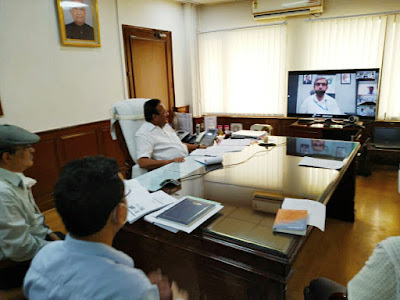National News
Indian Navy inducts indigenously developed Advanced Torpedo Decoy System Maareech
- The Indian Navy has inducted the Advanced Torpedo Decoy System ‘Maareech’ in its fleet on 26 June 2020, to further enhance the Anti-Submarine Warfare capability of the Indian Navy
- Maareech is capable of being fired from all frontline warships.
- The Design and Development of this anti-torpedo decoy system has been undertaken indigenously by DRDO labs-(NSTL and NPOL).
- Meanwhile, the Bharat Electronics Limited, a Defence PSU, would undertake the production of this decoy system.
India among Switzerland’s top-3 partners for getting info on bank accounts
- India is among the top-three countries to get detailed information from Switzerland on request about bank accounts and beneficiary ownership of entities established by their residents in the Alpine nation, as per the latest study by Organisation for Economic Cooperation and Development’s (OECD’s) Global Forum on transparency and exchange of information for tax purposes.
- The Global Forum’s latest peer review report on exchange of information on request, during the period from July 2015 to June 2018,features India among the top-three jurisdictions, helping India to launch prosecution against a large number of alleged tax evaders..
- The other two countries were France and Germany.
Banking & Economy News
World Bank Approves USD 500 mn loan to improve quality of education system in 6 Indian States
- The World Bank has approved loan worth $500 million (about Rs 3,700 crore) for Strengthening Teaching-Learning and Results for States Program (STARS) on June 24, 2020, to improve quality and governance of school education in six Indian states.
- The STARS program builds on the long partnership between India and the World Bank (since 1994), for strengthening public school education and to support the country’s goal of providing Education for All.
- The six states are Himachal Pradesh, Kerala, Madhya Pradesh, Maharashtra, Odisha, and Rajasthan.
RBI extends enhanced borrowing limit under MSF till 30 September
- In March 2020, the Reserve Bank of India, had increased the borrowing limit of scheduled banks under the marginal standing facility (MSF) scheme from 2 percent to 3 percent of their Net Demand and Time Liabilities (NDTL) as a temporary measure to deal with cash crunch caused by coronavirus pandemic.
- This relaxation was effective from March 27, 2020 and was granted till June 30, 2020.
- Now, RBI has decided to extend this enhanced borrowing facility provided to the banks to meet their liquidity shortages till September 30, 2020.
- Apart from this, the Central Bank has also extended the relaxation on the minimum daily maintenance of the Cash Reserve Ratio (CRR) at 80 percent for a further period of three months till September 25, 2020.
- On March 27, the minimum daily maintenance of the CRR was reduced from 90 percent of the prescribed CRR to 80 percent till June 26, 2020 due to the hardships faced by banks in terms of social distancing of staff and consequent strains on reporting requirements.
Sidbi sets up Swavalamban Crisis Responsive Fund to facilitate free onboarding of MSMEs on TReDS platform
- The Small Industries Development Bank of India (SIDBI) has set up ‘Swavalamban Crisis Responsive Fund’ to support free onboarding for micro, small and medium enterprises (MSMEs) on trade receivables discounting system (TReDS).
- The initiative aims to offer relief to the MSMEs from severely crunched cash flow, during these challenging times.
- The free onboarding of MSMEs would be available till September 2000.
- It is an open-ended fund with the target to onboard 10,000 MSMEs during this period.
- Usually, an MSME has to pay a fee of Rs 5,000 to Rs 10,000 for getting registered on a TReDS platform.
- Three TReDS platforms namely Receivables Exchange of India Ltd (RXIL), M1xchange and Invoicemart will help MSMEs to gain access to working capital through invoice discounting via multiple financiers.
PhonePe partners with ICICI Bank on UPI multi-bank model
- Flipkart-owned PhonePe has partnered with ICICI Bank on UPI multi-bank model giving its users the option to create and use multiple UPI IDs with ICICI and Yes Bank”s handles.
- The ‘@ibl’ handle for ICICI Bank users and ‘@ybl’ handle for YES Bank users will enable easy, quick and contactless payment services to over 200 million registered PhonePe users.
- The PhonePe customers will now be able to choose between multiple handles for their UPI IDs, thus making payments easy, secure and accessible to all.
Important Days
National Statistics Day: 29 June
- The Government of India celebrates Statistics Day on June 29 every year since 2007 to popularize the use of Statistics in everyday life and sensitize the public as to how Statistics helps in shaping and framing policies.
- The day marks the birth anniversary of Father of Indian Statistics, Prof. P C Mahalanobis, in recognition of his invaluable contribution in establishing the National Statistical System.
- The theme of Statistics Day, 2020 is SDG- 3 (Ensure healthy lives and promote well-being for all at all ages) & SDG- 5 (Achieve gender equality and empower all women and girls).













